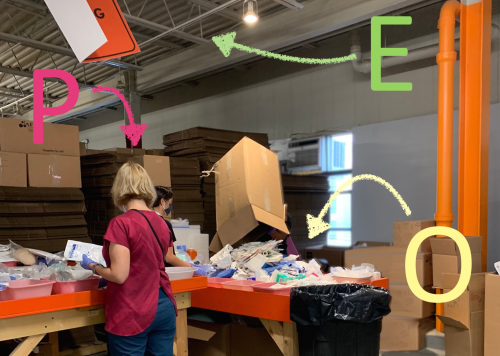Occupational Therapy Student Blog Post
December 14, 2020
Carina Frantz, Mercy College Occupational Therapy Program
My internship as an occupational therapy student at Afya Foundation has illustrated for me how vital a holistic approach is to occupational therapy (OT). Combining medical and social models, OT understands that people have been shaped by ongoing physical and psychosocial forces to produce individuals with uniquely tangled histories, identities and physicalities. Moreover, when these personal characteristics are applied to functional performance, success is influenced both by the environmental setting and the properties of the specific activity (Hooper, 2014). This interdependence is nicely captured in the Person-Environment-Occupation model (P-E-O).
P-E-O views the performance of a task as a product of how its three components intersect – person, environment, and occupation. Holistic interventions address each, adjusting any of the three domains to optimize how well they fit together to support successful participation (Baptiste, 2017).
At the Afya Foundation’s warehouse, this P-E-O approach helps individuals find the best adjustments to allow the best performance – be it for landing a future job, living independently, or engaging in the activities they love best.
My client, Kevin, has autism spectrum disorder (ASD) and comes to Afya to develop task proficiency and social skills. He is also a fierce juggler, a skill he occasionally shares with his fellow warehouse workers – although we discourage the juggling of medical supplies. However, such deft skills with timing, dexterity, and hand-eye coordination don’t translate directly to Afya’s sorting tables, where tasks involving multi-step processes, date tracking, and divided attention present different challenges. So simple task modifications are applied, like chunking into shorter segments and sorting for single items, that allow Kevin to actively participate in purposeful work and continue building skills.
The environment at Afya is the third component impacting performance. Afya is a warehouse, with open spaces, constant foot traffic, and echoing walls that amplify the social milieu of conversation and music. On a particularly bustling day, I could see that Kevin was more unfocused than usual. I worried that sensory processing issues with sound or proximity that Kevin might experience through his ASD could be impacting his ability to perform.
But checking in, I found Kevin was doing just fine! I soon realized that it was my own hyperacusis, or over-sensitivity to noise, that was impacting my performance, as my focus began to fade and spaciness set in. For Kevin, the distraction was different – his love of socializing, atypically heightened with lively conversation and new faces that day, was continually drawing his concentration away from his work. Same occupation; same environment; different persons.
When considering future job opportunities, Afya’s P-E-O intersections can provide important insights. For Kevin, a job with two-step tasks in an environment with few social distractions will best aid his success. For me, on the other hand, modifications to auditory levels will help me function at my best.
Lying at the intersection of a person, an environment, and a task, successful performance emerges as each element aligns into an integrated whole.
Sources:
Baptiste, S. (2017). The person-environment-occupation model, In Hinojosa, J., Kramer, P., Royeen, C.B. (Eds), Perspectives on human occupation: Theories underlying practice, 2nd ed. Philadelphia, PA: F.A. Davis.
Hooper, Barbara and Wendy Wood (2014). The philosophy of occupational therapy: A framework for practice, in Willard and Spackman’s occupational therapy, 12th edition, eds. Barbara A. Schell, Glen Gillen, Marjorie Scaffa, and Ellen S. Cohn. Philadelphia, PA: Lippincott Williams & Wilkins.

